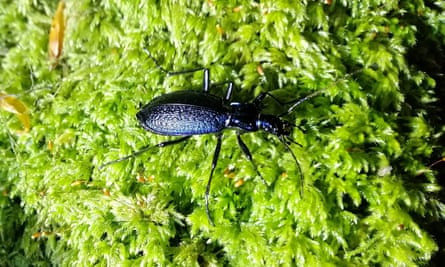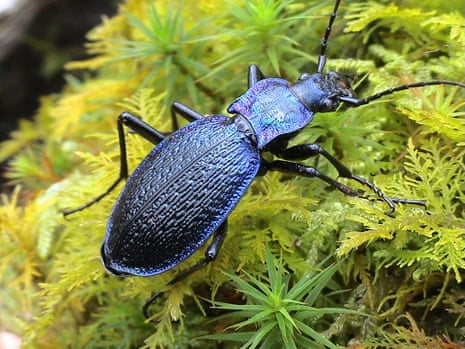Evening light is fading fast as the four of us make our way into the darkness beneath the woodland canopy, our head-torch beams searching the low vegetation and boughs for invertebrate life.
I can hear the River Dart racing through a gully nearby on its journey south off Dartmoor, and catch glimpses of the shallow flow frayed into silver shreds by the rocky riverbed.
We reach a small clearing and begin playing our lights up and down the trunks of surrounding oaks in the hope of spotting the rare nocturnal hunter we have come to find.
Our guide is the entomologist John Walters, and I am with two other wildlife enthusiasts also hoping to catch their first sighting of a blue ground beetle (Carabus intricatus). Believed to have become extinct in the UK during the 20th century, this elusive inhabitant of damp deciduous woodland was rediscovered on Dartmoor in 1985. It has since been found at a few scattered locations in the West Country, including this riverside section of the Dart Valley reserve and, more recently, in Wales.

John advises us to check the south-facing stands of oak. An active predator by night, with long legs and formidable jaws, the blue ground beetle typically climbs trees in search of the slugs on which it feeds.
We soon strike lucky. Ten feet up, picked out in a torch beam, is an oval of jet black more than an inch long, thin feet pinning it to the bare bark like a brooch. The largest of Britain’s 360-plus ground beetle species, it is an impressive sight even at a distance.
Neighbouring trunks are wrapped in tourniquets of ivy or covered with moss, and it is among these old trees that we find a second beetle, closer to the forest floor. In the torchlight, a hint of its metallic blue sheen is visible.
Although it moves fast, the blue ground beetle is unable to fly, making isolated colonies particularly vulnerable. It was heartening then to find 10 of them during our search, including a mating pair – a rare sight. All being well, a new generation will soon join the ranks on nightly slug patrol in this Dartmoor wood.

Comments (…)
Sign in or create your Guardian account to join the discussion